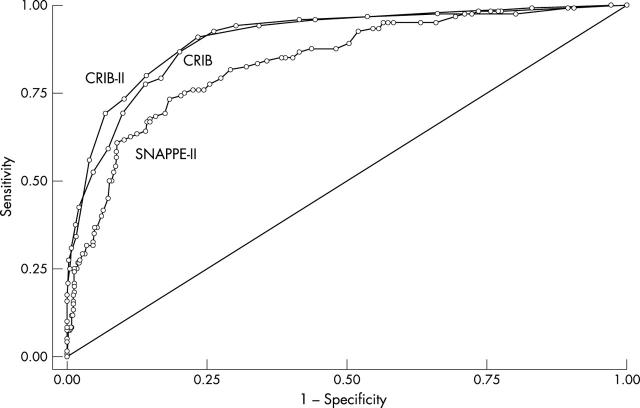Abstract
Background: Illness severity scores are increasingly used for risk adjustment in clinical research and quality assessment. Recently, a simplified version of the score for neonatal acute physiology (SNAPPE-II) and a revised clinical risk index for babies (CRIB-II) score have been published.
Aim: To compare the discriminatory ability and goodness of fit of CRIB, CRIB-II, and SNAPPE-II in a cohort of neonates < 1500 g birth weight (VLBWI).
Methods: Data from 720 VLBWI, admitted to 12 neonatal units in Lombardy (Northern Italy) participating in a regional network, were analysed. The discriminatory ability of the scores was assessed measuring the area under the receiver operating characteristic curve (AUC). Outcome measure was in-hospital death.
Results: CRIB and CRIB-II showed greater discrimination than SNAPPE-II (AUC 0.90 and 0.91 v 0.84, p < 0.0004), partly because of the poor quality of some of the data required for the SNAPPE-II calculation—for example, urine output—but also because of the relative weight given to some items. In addition to each score, several variables significantly influenced survival in logistic regression models. Antenatal steroid prophylaxis, singleton birth, absence of congenital anomalies, and gestational age were independent predictors of survival for all scores, in addition to caesarean section and not being small for gestation (for SNAPPE-II) and a five minute Apgar score of ⩾ 7 (for SNAPPE-II and CRIB).
Conclusions: CRIB and CRIB-II had greater discriminatory ability than SNAPPE-II. Risk adjustment using all scores is imperfect, and other perinatal factors significantly influence VLBWI survival. CRIB-II seems to be less confounded by these factors.
Full Text
The Full Text of this article is available as a PDF (75.9 KB).
Figure 1.
Receiver operating characteristics curves for the clinical risk index for babies (CRIB), CRIB-II, and score for neonatal acute physiology—perinatal extension (SNAPPE-II). The area under the curve: CRIB, 0.903; CRIB-II, 0.907; SNAPPE-II, 0.837.
Selected References
These references are in PubMed. This may not be the complete list of references from this article.
- Baumer J. H., Wright D., Mill T. Illness severity measured by CRIB score: a product of changes in perinatal care? Arch Dis Child Fetal Neonatal Ed. 1997 Nov;77(3):F211–F215. doi: 10.1136/fn.77.3.f211. [DOI] [PMC free article] [PubMed] [Google Scholar]
- Eriksson M., Bodin L., Finnström O., Schollin J. Can severity-of-illness indices for neonatal intensive care predict outcome at 4 years of age? Acta Paediatr. 2002;91(10):1093–1100. doi: 10.1080/080352502760311601. [DOI] [PubMed] [Google Scholar]
- Escobar G. J., Fischer A., Li D. K., Kremers R., Armstrong M. A. Score for neonatal acute physiology: validation in three Kaiser Permanente neonatal intensive care units. Pediatrics. 1995 Nov;96(5 Pt 1):918–922. [PubMed] [Google Scholar]
- Field D., Manktelow B., Draper E. S. Bench marking and performance management in neonatal care: easier said than done! Arch Dis Child Fetal Neonatal Ed. 2002 Nov;87(3):F163–F164. doi: 10.1136/fn.87.3.F163. [DOI] [PMC free article] [PubMed] [Google Scholar]
- Fowlie P. W., Gould C. R., Tarnow-Mordi W. O., Strang D. Measurement properties of the Clinical Risk Index for Babies--reliabilty, validity beyond the first 12 hours, and responsiveness over 7 days. Crit Care Med. 1998 Jan;26(1):163–168. doi: 10.1097/00003246-199801000-00033. [DOI] [PubMed] [Google Scholar]
- Gagliardi Luigi, Barbarini Mario, Pugni Lorenza, Mosca Fabio. Effect of changes in inspired oxygen tension on indexes of oxygenation in ventilated neonates. Pediatr Crit Care Med. 2002 Jan;3(1):34–38. doi: 10.1097/00130478-200201000-00009. [DOI] [PubMed] [Google Scholar]
- Hanley J. A., McNeil B. J. The meaning and use of the area under a receiver operating characteristic (ROC) curve. Radiology. 1982 Apr;143(1):29–36. doi: 10.1148/radiology.143.1.7063747. [DOI] [PubMed] [Google Scholar]
- Marlow N. Illness severity measures in neonatal intensive care. Acta Paediatr. 2002;91(4):367–368. doi: 10.1080/080352502317371544. [DOI] [PubMed] [Google Scholar]
- Parry Gareth, Tucker Janet, Tarnow-Mordi William, UK Neonatal Staffing Study Collaborative Group CRIB II: an update of the clinical risk index for babies score. Lancet. 2003 May 24;361(9371):1789–1791. doi: 10.1016/S0140-6736(03)13397-1. [DOI] [PubMed] [Google Scholar]
- Perlman M. Neonatal intensive care unit report cards. Pediatrics. 1998 Oct;102(4 Pt 1):975–976. doi: 10.1542/peds.102.4.975. [DOI] [PubMed] [Google Scholar]
- Petridou E., Richardson D. K., Dessypris N., Malamitsi-Puchner A., Mantagos S., Nicolopoulos D., Papas C., Salvanos H., Sevastiadou S., Sofatzis J. Outcome prediction in Greek neonatal intensive care units using a score for neonatal acute physiology (SNAP) Pediatrics. 1998 Jun;101(6):1037–1044. doi: 10.1542/peds.101.6.1037. [DOI] [PubMed] [Google Scholar]
- Pollack M. M., Koch M. A., Bartel D. A., Rapoport I., Dhanireddy R., El-Mohandes A. A., Harkavy K., Subramanian K. N. A comparison of neonatal mortality risk prediction models in very low birth weight infants. Pediatrics. 2000 May;105(5):1051–1057. doi: 10.1542/peds.105.5.1051. [DOI] [PubMed] [Google Scholar]
- Rautonen J., Mäkelä A., Boyd H., Apajasalo M., Pohjavuori M. CRIB and SNAP: assessing the risk of death for preterm neonates. Lancet. 1994 May 21;343(8908):1272–1273. doi: 10.1016/s0140-6736(94)92158-x. [DOI] [PubMed] [Google Scholar]
- Richardson D. K., Corcoran J. D., Escobar G. J., Lee S. K. SNAP-II and SNAPPE-II: Simplified newborn illness severity and mortality risk scores. J Pediatr. 2001 Jan;138(1):92–100. doi: 10.1067/mpd.2001.109608. [DOI] [PubMed] [Google Scholar]
- Richardson D. K., Phibbs C. S., Gray J. E., McCormick M. C., Workman-Daniels K., Goldmann D. A. Birth weight and illness severity: independent predictors of neonatal mortality. Pediatrics. 1993 May;91(5):969–975. [PubMed] [Google Scholar]
- Richardson D. K., Tarnow-Mordi W. O., Escobar G. J. Neonatal risk scoring systems. Can they predict mortality and morbidity? Clin Perinatol. 1998 Sep;25(3):591–611. [PubMed] [Google Scholar]
- Richardson D., Tarnow-Mordi W. O., Lee S. K. Risk adjustment for quality improvement. Pediatrics. 1999 Jan;103(1 Suppl E):255–265. [PubMed] [Google Scholar]
- Sutton L., Bajuk B., Berry G., Sayer G. P., Eagles B. L., Henderson-Smart D. J. Reliability of the SNAP (score of neonatal acute physiology) data collection in mechanically ventilated term babies in New South Wales, Australia. Acta Paediatr. 2002;91(4):424–429. doi: 10.1080/080352502317371661. [DOI] [PubMed] [Google Scholar]
- Tarnow-Mordi W., Ogston S., Wilkinson A. R., Reid E., Gregory J., Saeed M., Wilkie R. Predicting death from initial disease severity in very low birthweight infants: a method for comparing the performance of neonatal units. BMJ. 1990 Jun 23;300(6740):1611–1614. doi: 10.1136/bmj.300.6740.1611. [DOI] [PMC free article] [PubMed] [Google Scholar]



